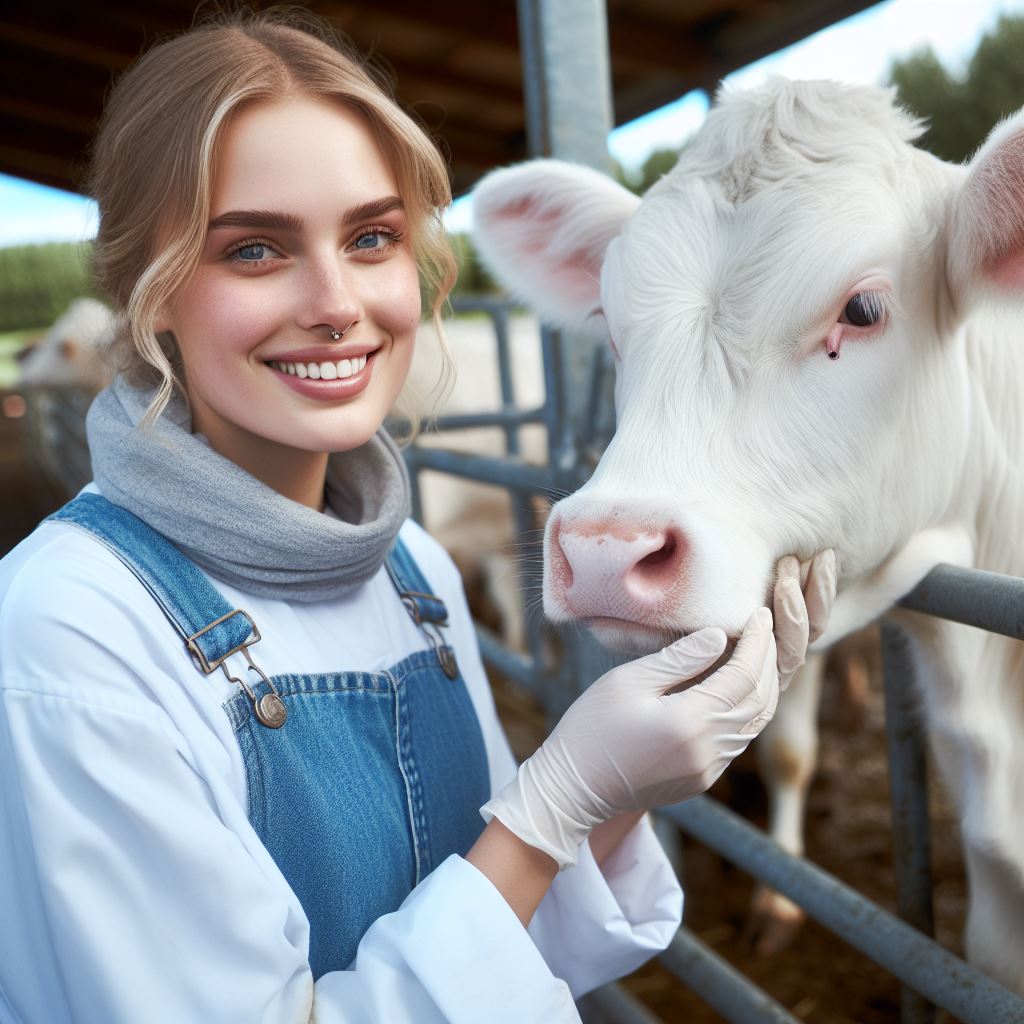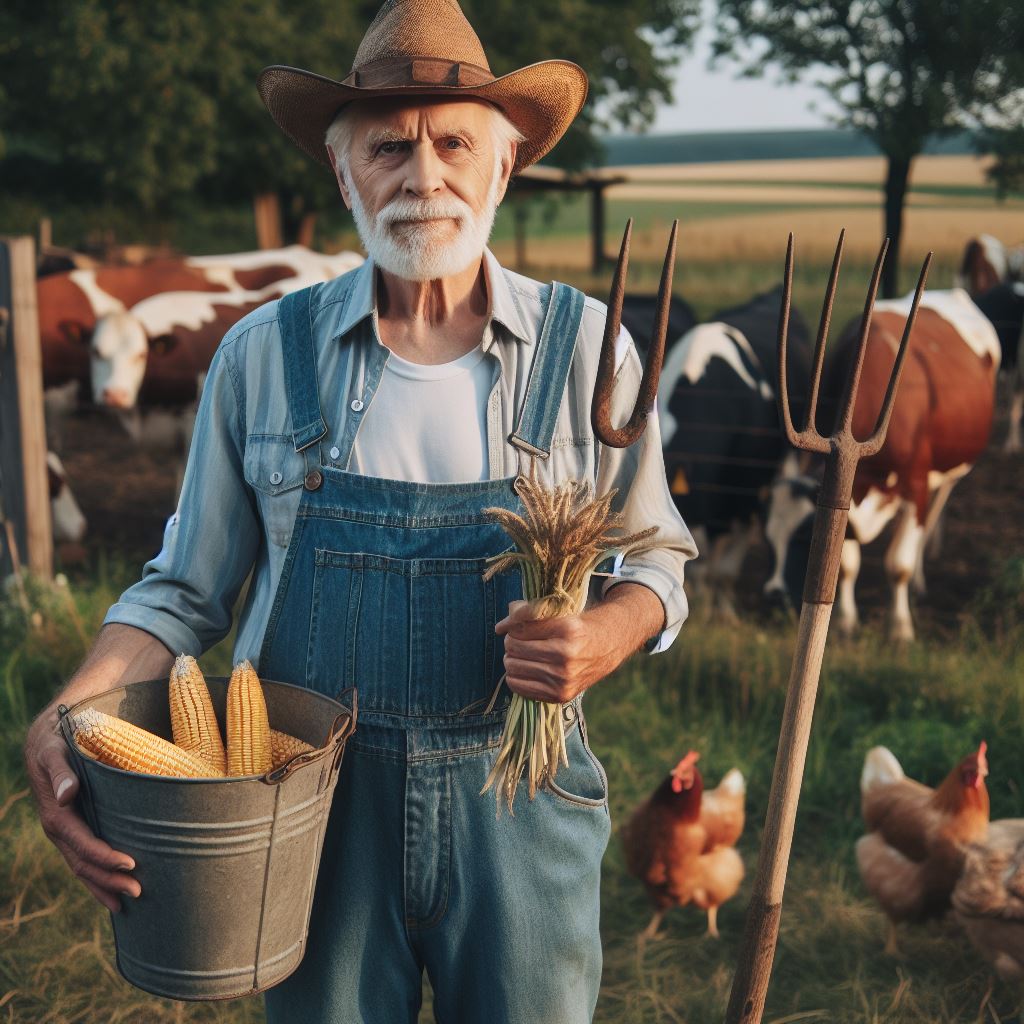Introduction
Climate-smart agriculture is essential in combating climate change by adapting to and reducing its impacts.
Climate-smart agriculture aims to sustainably increase productivity, enhance resilience, and reduce greenhouse gas emissions.
It includes practices such as conservation farming and efficient water management.
Livestock rearing has a significant impact on the environment, contributing to greenhouse gas emissions, deforestation, water pollution, and soil degradation.
By implementing climate-smart livestock rearing practices, such as rotational grazing and improved feed management, we can mitigate these environmental impacts.
Climate-smart livestock rearing also promotes animal health and welfare, improves productivity, and enhances the resilience of farmers.
The integration of climate-smart agriculture principles into livestock rearing offers a win-win situation: mitigating climate change while ensuring sustainable food production.
Through sustainable practices, such as agroforestry and proper waste management, we can reduce methane emissions from livestock.
Furthermore, integrating renewable energy sources, such as solar power, can minimize the carbon footprint of livestock operations.
It is crucial for governments, farmers, and consumers to collaborate to support and promote climate-smart livestock rearing.
In short, climate-smart livestock rearing plays a vital role in mitigating climate change, ensuring food security, and promoting sustainable agriculture.
By adopting these practices, we can protect our planet for future generations.
Understanding Climate-Smart Livestock Rearing
Climate-Smart Livestock Rearing refers to the adoption of sustainable practices in the livestock industry to mitigate climate change impacts.
This approach aims to increase productivity, enhance resilience, and reduce greenhouse gas emissions.
By following climate-smart principles, farmers can ensure the long-term sustainability of their livestock operations.
Transform Your Agribusiness
Unlock your farm's potential with expert advice tailored to your needs. Get actionable steps that drive real results.
Get StartedDefinition and principles of climate-smart livestock rearing
- Sustainable practices: Climate-smart livestock rearing involves the implementation of environmentally friendly and socially responsible techniques.
- Adaptation: It focuses on enhancing livestock resilience to withstand changing climate conditions.
- Mitigation: This principle strives to reduce greenhouse gas emissions from livestock production.
- Productivity: Climate-smart rearing aims to improve livestock productivity while minimizing resource use and environmental degradation.
- Resilience: It emphasizes building resilient livestock systems that can cope with climate uncertainties and shocks.
Importance of sustainable practices in the livestock industry
- Environmental impact: Sustainable practices in livestock rearing help reduce pollution, preserve biodiversity, and protect natural resources.
- Climate change mitigation: By adopting climate-smart approaches, the livestock industry can contribute to global efforts in mitigating climate change.
- Socio-economic benefits: Sustainable practices create job opportunities, improve food security, and enhance rural livelihoods.
- Animal welfare: Climate-smart rearing promotes better animal welfare, ensuring their health and minimizing stress.
Benefits of climate-smart livestock rearing for farmers
- Increased productivity: Implementing sustainable practices can lead to higher livestock yields, resulting in increased income for farmers.
- Cost savings: Efficient resource management reduces input costs, enhancing the profitability of livestock operations.
- Risk reduction: Climate-smart rearing enables farmers to mitigate the risks associated with climate variability and extreme weather events.
- Access to markets: Meeting sustainability requirements opens doors to premium markets and higher-priced products.
- Long-term viability: By adopting climate-smart principles, farmers can secure the long-term viability of their livestock businesses.
In fact, climate-smart livestock rearing is a vital approach for the sustainability of the livestock industry.
By understanding and implementing climate-smart principles, farmers can enhance productivity, reduce greenhouse gas emissions, and build resilient livestock systems.
These sustainable practices not only benefit the environment but also provide economic and social advantages for farmers.
Read: Sustainable Animal Health Care
Climate-Smart Feed Management
As the world continues to grapple with the effects of climate change, it has become increasingly important to adopt sustainable practices in all aspects of our lives.
Livestock rearing, in particular, is a sector that greatly contributes to greenhouse gas emissions. One area that requires immediate attention is feed management.
By adopting climate-smart feed management practices, we can significantly reduce the environmental impact of livestock rearing.
Introduction to Sustainable Feed Options
Traditional feed options, such as grain-based diets, require extensive land use and contribute to deforestation.
However, sustainable feed options offer a way to mitigate these issues. One such option is utilizing locally available forage resources for animal feed.
By doing so, we can reduce the need for land-intensive feed production and minimize transportation emissions.
Another sustainable feed option is incorporating by-products from the food and agriculture industries.
Rather than wasting valuable resources, these by-products can be used as feed, reducing the overall environmental footprint of livestock rearing.
Additionally, exploring alternative protein sources, such as insects or algae, can provide a sustainable and nutritious feed option for animals.
Explanation of Various Feed Management Practices to Reduce Greenhouse Gas Emissions
Implementing certain feed management practices can significantly reduce greenhouse gas emissions associated with livestock rearing.
One such practice is optimizing feed formulation. By carefully balancing the nutritional requirements of animals, we can minimize the amount of feed needed and reduce methane emissions from digestion.
Another effective practice is incorporating feed additives that help improve digestion efficiency and reduce methane emissions.
For example, adding certain plant extracts or enzymes to animal feed can promote better digestion and decrease the release of greenhouse gases into the atmosphere.
Furthermore, implementing precision feeding techniques can help minimize feed waste and, subsequently, reduce methane emissions.
By accurately determining the nutritional requirements of each animal, we can avoid overfeeding and optimize feed utilization.
Importance of Balancing Animal Nutrition with Environmental Concerns
While it is essential to prioritize animal nutrition, we must also consider the environmental impact of our choices.
A balanced approach to feed management is crucial, as it ensures that animals receive proper nutrition while minimizing negative environmental consequences.
Proper feed management not only reduces greenhouse gas emissions but also conserves water resources.
For example, optimizing feed formulation and implementing precision feeding techniques can minimize the water footprint associated with livestock rearing.
Additionally, sustainable feed management can contribute to biodiversity conservation.
Showcase Your Farming Business
Publish your professional farming services profile on our blog for a one-time fee of $200 and reach a dedicated audience of farmers and agribusiness owners.
Publish Your ProfileBy reducing reliance on land-intensive feed production, we can protect natural habitats and preserve biodiversity, ultimately leading to a healthier and more resilient ecosystem.
In essence, climate-smart feed management plays a vital role in reducing the environmental impact of livestock rearing.
By adopting sustainable feed options, implementing effective feed management practices, and balancing animal nutrition with environmental concerns, we can make significant strides towards a more sustainable and climate-resilient future.
Read: Green Livestock Breeding Practices
Efficient Water and Manure Management
Optimizing water usage in livestock rearing
Optimizing water usage in livestock rearing is crucial to ensure the sustainability of this practice.
One efficient way to conserve water is by implementing proper watering systems that prevent wastage.
Investing in technologies like automatic waterers and drip irrigation systems can significantly reduce water consumption.
Regularly monitoring and maintaining water quality is essential for the health and well-being of the livestock.
Implementing a water recycling system can further enhance water efficiency in livestock rearing operations.
Efficient water management not only conserves this precious resource but also reduces the environmental impact.
Best practices for manure management
Manure management is another critical aspect of climate-smart livestock rearing.
Implementing best practices for manure management minimizes environmental pollution and maximizes resource usability.
One effective approach is to compost the manure, which helps stabilize nutrients and reduce odor.
Proper storage and handling of manure can also prevent leaching and contamination of water sources.
Utilizing manure as organic fertilizer enriches the soil, improving its quality and reducing the need for chemical inputs.
Effective manure management reduces greenhouse gas emissions, a significant contributor to climate change.
Impacts of water and manure management on environmental sustainability
By optimizing water and manure management, livestock rearing can contribute to environmental sustainability.
Efficient water usage reduces the strain on freshwater resources, ensuring their availability for other essential purposes.
Proper manure management prevents pollution of water bodies, safeguarding aquatic ecosystems and human health.
Smart practices in water and manure management can improve soil health, promoting sustainable land use.
Adopting climate-smart techniques mitigates the environmental impact and enhances the resilience of livestock farming.
Harnessing renewable energy sources, such as solar power, for water pumping and manure processing further reduces carbon emissions.
Integrating livestock rearing with agroforestry systems can provide shade, conserve water, and sequester carbon.
Collaboration between farmers, scientists, and policymakers is crucial for promoting climate-smart livestock rearing practices.
Government support and incentives can encourage farmers to adopt efficient water and manure management techniques.
Training programs and awareness campaigns play a vital role in empowering farmers to implement climate-smart strategies.
Educating consumers about the importance of supporting sustainable livestock practices can drive market demand.
In general, efficient water and manure management in climate-smart livestock rearing are vital for environmental sustainability.
Optimizing water usage and implementing best practices for manure management reduce the environmental impact and enhance resource efficiency.
Collaborative efforts and support from stakeholders are necessary to promote climate-smart livestock rearing and create a sustainable future.
Read: Livestock Waste Management 101
Enhancing Livestock Health and Welfare
Livestock rearing plays a significant role in global food production. However, it is crucial to ensure the health and welfare of animals to maintain sustainable practices.
Here, we will discuss the importance of sustainable animal health practices, holistic approaches to animal welfare, and the benefits of healthy livestock on the environment.
Importance of Sustainable Animal Health Practices
- Prevention is better than cure: Implementing sustainable animal health practices helps prevent diseases, reducing the need for extensive treatment and minimizing the use of antibiotics.
- Improved productivity: Healthy livestock are more productive, resulting in increased quality and quantity of animal products such as milk, meat, and eggs.
- Economic sustainability: By investing in animal health, farmers can save money on costly treatments and ensure long-term economic viability.
Holistic Approaches to Animal Welfare
- Proper nutrition: Providing a balanced diet with required nutrients is essential for animals’ overall well-being and immune system strengthening.
- Comfortable housing: Livestock should have access to clean and spacious shelters, protecting them from extreme weather conditions and reducing stress levels.
- Regular veterinary care: Routine check-ups, vaccinations, and prompt treatment of illnesses are crucial to ensure the welfare of livestock.
- Stress reduction: Minimizing handling stress, avoiding overcrowding, and maintaining social interactions among animals contribute to their well-being.
Benefits of Healthy and Well-Cared-for Livestock on the Environment
- Reduced greenhouse gas emissions: Healthy animals produce less methane, a potent greenhouse gas responsible for climate change.
- Efficient resource utilization: Healthy livestock utilize nutrients more efficiently, minimizing excessive use of feed and water resources.
- Sustainable waste management: Proper care of livestock reduces environmental pollution caused by animal waste and promotes responsible manure management.
- Biodiversity preservation: Adhering to sustainable livestock rearing practices helps preserve biodiversity by preventing overgrazing and habitat degradation.
In brief, enhancing livestock health and welfare is essential for sustainable livestock rearing.
By implementing sustainable animal health practices, adopting holistic approaches to animal welfare, and recognizing the benefits of healthy livestock on the environment, we can ensure a more resilient and eco-friendly livestock industry.
Prioritizing the well-being of animals not only supports global food production but also contributes to a healthier planet for future generations.
Read: Rotational Grazing: Benefits & Tips

Harnessing Renewable Energy in Livestock Rearing
In today’s world, where the conservation of our environment is of utmost importance, the livestock industry also needs to make changes to ensure sustainability.
One way to achieve this is by harnessing renewable energy sources to power farms and reduce environmental impact.
Renewable energy, unlike fossil fuels, comes from sources that are naturally replenished and do not harm the planet.
Showcase Your Farming Business
Publish your professional farming services profile on our blog for a one-time fee of $200 and reach a dedicated audience of farmers and agribusiness owners.
Publish Your ProfileLet’s explore the various renewable energy sources applicable to the livestock industry and the advantages of transitioning to them.
Renewable energy sources applicable to the livestock industry
Solar power is one of the most popular forms of renewable energy used in livestock operations.
By installing solar panels on farm buildings, farmers can harness the power of the sun to generate electricity.
This clean and abundant source of energy can be used to run electrical equipment, like lighting, ventilation systems, and water pumps on the farm.
Furthermore, excess solar energy generated during the day can be stored in batteries for use during the night.
Wind energy is another promising renewable energy source for powering livestock farms. Farms situated in windy areas can install wind turbines to generate electricity.
As the wind blows, the rotating blades of the turbine produce electricity that can be used to power various farm operations.
Beyond farming needs, surplus power can even be sold to the grid, providing an additional source of income for farmers.
Biogas is a renewable energy source that is produced through the anaerobic digestion of organic materials such as livestock manure.
Livestock operations have a significant amount of organic waste that can be used to produce biogas.
The biogas, composed mainly of methane, can be used as a clean fuel for cooking, heating, or even generating electricity.
Additionally, the process of anaerobic digestion reduces the release of methane into the atmosphere, a potent greenhouse gas.
Hydropower, although not directly applicable to most livestock farms, can be used in areas where water resources are readily available.
Farmers can install small-scale hydropower systems, such as micro-hydropower turbines, in rivers or streams on their properties.
The flowing water turns the turbine, generating electricity that can be used on the farm. This method is particularly useful for remote or off-grid farms that have access to running water.
Advantages of transitioning to renewable energy for powering farms
Transitioning to renewable energy sources in livestock rearing offers several advantages.
First and foremost, it significantly reduces greenhouse gas emissions. As the livestock industry is a major contributor to carbon emissions, utilizing renewable energy helps mitigate climate change.
Moreover, renewable energy sources are often cheaper in the long run, leading to reduced operational costs for farmers.
This can provide financial stability and a competitive edge for livestock operations.
Case studies or examples of successful integration of renewable energy in livestock operations
Successful integration of renewable energy in livestock operations has been demonstrated through numerous case studies.
For instance, a dairy farm in California installed solar panels on their barn roofs, generating almost 80% of their electricity needs.
This reduced their reliance on fossil fuels and saved them thousands of dollars in energy costs. Similarly, a pig farm in
Denmark utilized biogas from manure to produce electricity, heat, and even vehicle fuel, becoming energy self-sufficient.
In review, harnessing renewable energy sources in livestock rearing is a vital step towards creating a climate-smart future.
Solar power, wind energy, biogas, and hydropower offer sustainable alternatives to power farms while reducing environmental impact.
From reducing carbon emissions to cost savings and energy independence, the advantages of transitioning to renewable energy for powering livestock farms are abundant.
Embracing this change can lead to a greener and more sustainable livestock industry.
Policy and Economic Incentives for Climate-Smart Livestock Rearing
Overview of government policies and subsidies supporting sustainable practices
In recent years, the concept of climate-smart livestock rearing has gained significant attention due to its potential to address the challenges posed by climate change.
Governments around the world have recognized the importance of promoting sustainable practices in the livestock sector and have implemented various policies and subsidies to support them.
One of the key aspects of government policies is the encouragement of sustainable practices such as improved feed efficiency, waste management, and emissions reduction.
By providing financial incentives and technical support, governments aim to motivate farmers to adopt climate-smart practices.
Subsidies play a crucial role in supporting sustainable livestock rearing.
Governments offer subsidies to farmers for adopting climate-smart technologies, such as renewable energy systems, efficient manure management systems, and improved livestock housing.
These subsidies help reduce the upfront costs and make sustainable practices more economically feasible for farmers.
Furthermore, governments have also introduced regulations and standards to promote sustainable livestock rearing.
By enforcing stricter environmental regulations, governments aim to incentivize farmers to adopt practices that reduce greenhouse gas emissions and minimize the negative impact on the environment.
Economic benefits and cost-saving opportunities for farmers
When it comes to economic benefits, climate-smart livestock rearing presents numerous opportunities for farmers.
By adopting sustainable practices, farmers can reduce their production costs in the long run.
For example, implementing efficient feeding strategies can reduce the amount of feed required, resulting in significant cost savings.
In addition to cost savings, sustainable livestock rearing can also lead to increased productivity.
Showcase Your Farming Business
Publish your professional farming services profile on our blog for a one-time fee of $200 and reach a dedicated audience of farmers and agribusiness owners.
Publish Your ProfileBy focusing on animal health and welfare, farmers can improve the overall performance of their livestock, resulting in higher yields and better quality products.
This, in turn, can lead to higher profits for farmers.
Importance of collective actions and collaborations to drive change
Beyond individual benefits, there is a growing recognition of the importance of collective actions and collaborations to drive change in the livestock sector.
Governments, farmers, researchers, and other stakeholders need to work together to develop and implement effective strategies for climate-smart livestock rearing.
Collective actions can include knowledge sharing, capacity building, and establishing platforms for collaboration.
By sharing best practices and experiences, farmers can learn from each other and implement innovative solutions on their farms.
Collaboration among stakeholders can also help identify and address barriers to the adoption of sustainable practices.
In a nutshell, government policies and economic incentives serve as powerful drivers for climate-smart livestock rearing.
By promoting sustainable practices, governments aim to reduce the environmental impact of the livestock sector while providing economic benefits to farmers.
However, achieving widespread adoption of climate-smart practices requires collective actions and collaborations among all stakeholders.
Conclusion
Climate-smart livestock rearing practices are crucial for sustainable agriculture and combating climate change.
To recap, we discussed the importance of reducing methane emissions, implementing rotational grazing, and improving waste management.
As a call to action, it is essential for farmers to embrace these practices to minimize their environmental impact.
By adopting climate-smart livestock rearing, farmers can contribute to preserving the planet for future generations.
Sustainable agriculture plays a significant role in mitigating climate change, and it is our responsibility to embrace these practices.




